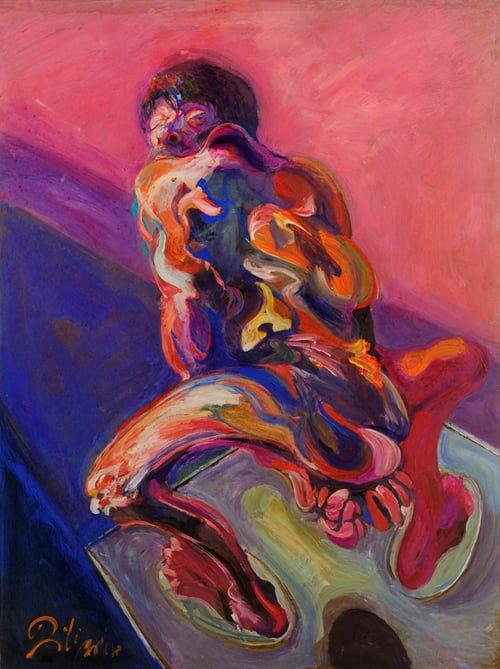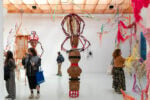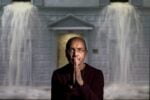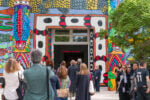Le psico-geografie sottili

Un’esposizione a tratti rigorosamente museale, anche se di grande apertura su di un personaggio forte e tuttora contrastato all’interno del panorama culturale a sud delle Alpi.
Comunicato stampa
SUBTLE PSYCHO-GEOGRAPHIES:
A CALVARY FOR THE IMAGE.
Felice Filippini & Jean Corty, Martin Disler, Otto Dix, Aurelio Gonzato, Hermann Hesse, Apollonio Pessina, Luigi Rossi, Louis Soutter, Varlin
curated by Mario Casanova & Pier Giorgio De Pinto
Vernissage__Saturday 8 September 2012 at 5.30 p.m.
8 September – 4 November 2012, Fri-Sat-Sun_2.00 - 6.00 p.m.
Felice Filippini, The falling dancer, 1969-70 (Felice Filippini Archive, Manno)
[Scorri verso il basso per la versione in italiano]
On 8 September 2012 at 5.30 p.m., the MACT/CACT CONTEMPORARY ART IN CANTON TICINO is inaugurating an exhibition with some strictly museum-like traits, albeit with considerable aperture towards a strong character who still arouses much opposition in cultural environs on the southern side of the Alps. As always, what the exhibition’s curators are tackling is not so much this great artist’s vision and his consequential impact on his native soil, as his deserved repositioning on the international art scene that came about during the great century of the avant-gardes and what goes by the epithet of modernity: those self-same methods of critical approach to the cultural and artistic milieu, restricted to the twentieth century, as a notable period in history not only of intellectual ferment, but also – and simultaneously – of a particular crisis of both cultural and social change.
This exhibition is a tribute to the stateless, eclectic figure of FELICE FILIPPINI (1917-1988), a writer, painter, journalist and thinker, who was cynical and reserved with regard to the dominant fashions and the social fabric in which he lived and worked.
Felice Filippini, Self-portrait with Dafne, 1941 (Felice Filippini Archive, Manno)
It is above all the facet of Filippini that sees him as a painter that will be tackled in this exhibition, which is rendered unique by its capacity to compare his visual output – from the end of the thirties to the end of the eighties – with the contemporary international scene: from his ideal identification with the Roman School and with Corrente, the literary artistic magazine outlawed by Mussolini’s Fascist regime in 1940, right up to his verging on Nordic Expressionism, in both cases starting from their Renaissance roots.
Born at the height of the Great War, whose moral and social disasters of a collapsing old European world order are recorded here by the presence of a work by Otto Dix (1891-1969) dating to 1917, Felice Filippini skilfully established a dialogue with the cultural humus of the following years and the artists who populated them and in one way or another nourished and regenerated his professional curiosity and the historical and societal ambient in which this Ticino native found himself working: from the period just after the second World War until his death.
The benchmarks cited in this exhibition include early references to the Swiss painter Luigi Rossi (1853-1923), an exponent of the nineteenth-century movement in Lombardy that – with Filippo Franzoni, Mosè Bianchi, Daniele Ranzoni, Federico Faruffini, Tranquillo Tremona and all the Lombard Scapigliatura in general, as well as others – breathed life into a vigorous artistic movement with a cross-border relevance between Ticino and Milan. The no less significant presence of such artists as Apollonio Pessina (1879-1958), Jean Corty (1907-1946) and Aurelio Gonzato (1914) constitutes a signal lesson and clear evidence of the extent to which the cultural osmosis between these Ticino artists and the ferment on the international art scene produced personalities of notable creative and cultural substance, in a Canton that has always been averse to acknowledging its native sons, or even to taking an interest in them.
Ever reluctant to yield to the siren songs of fashions and the avant-gardes, as a crucible of a tireless coherence more of style than of content, in the third phase of his artistic career, Filippini concentrated on the figure of man and his roots, of the society that gives birth to and educates him, while nevertheless perceiving the drastic sea-change that was already then about to burst upon him and was soon to revolutionise the second half of the last century, culminating in the crisis of ideologies heralded by the new millennium, as terrible as it has been irreversible and ultimately real: the fall of the middle-class model and its presumptions. The works he created at the end of the eighties – The Modern City (1988) and The Auto Cemetery (1987) – stigmatise and somehow represent the process of meltdown at work as the twentieth century drew to its close.
Louis Soutter, Les Broussailleurs, 1937-1942 (Matasci Foundation for Art, Tenero)
Water, death, the ship that bears survivors or humanity that falls and passes on, love affairs and sensual passions: these are the themes he developed obsessively, stripping every possible inhibitory veil from his emotional, ever-dissatisfied feeling and striving to reveal the mystery of existence and of its inexorable ending. Life, Death and Sexuality, like so many assumptions of human vanity, are represented here in a more terminological vein: the artist’s rapid and colourful gesture and the fragmentation of a society in search of an identity refer back to brutal Expressionist figures like Martin Disler (1949-1996), Louis Soutter (1871-1942) and Varlin (1900-1977).
With his important literary work IL SIGNORE DEI POVERI MORTI (The Lord of the Poor Dead, 1942), Felice Filippini left a testimony of a profoundly honest personality who was capable, like every true artist, of stating when the emperor wears no clothes, upsetting the social conventions of the priggish post-war European approach to global development and economic universality.
LE PSICO-GEOGRAFIE SOTTILI. IL CALVARIO DELL’IMMAGINE.
Felice Filippini & Jean Corty, Martin Disler, Otto Dix, Aurelio Gonzato,
Hermann Hesse, Apollonio Pessina, Luigi Rossi, Louis Soutter, Varlin
a cura di Mario Casanova & Pier Giorgio De Pinto
Vernissage__sabato 8 settembre 2012 dalle 17:30
8 settembre – 4 novembre 2012, ve-sa-do_14:00-18:00
Il MACT/CACT ARTE CONTEMPORANEA TICINO apre il prossimo 8 settembre 2012 alle ore 17:30 un’esposizione a tratti rigorosamente museale, anche se di grande apertura su di un personaggio forte e tuttora contrastato all’interno del panorama culturale a sud delle Alpi. Come sempre, i curatori della mostra affrontano non già la visione e il conseguente impatto indigeno verso questo grande artista, quanto il suo giusto riposizionamento all’interno di una scenografia internazionale dell’arte, disegnatasi proprio durante il grande secolo delle avanguardie e della cosiddetta modernità. Quelle stesse modalità di approccio critico all’universo culturale e artistico circoscritte al Novecento, quale notevole periodo storico di fermento intellettuale, ma – contemporaneamente – di particolare crisi del cambiamento, sia culturale che sociale.
Questa mostra è un omaggio alla figura apolide ed eclettica di FELICE FILIPPINI (1917-1988); scrittore, pittore, giornalista, pensatore scettico e schivo verso le mode dominanti e il tessuto sociale, in cui ha vissuto e operato.
Felice Filippini, Senza titolo (Autoritratto), 1970 circa (Archivio Felice Filippini, Manno)
Soprattutto la figura di Filipini pittore verrà affrontata in questa mostra, unica nel suo genere per la capacità di confronto della sua opera visiva – dalla fine degli anni ’30 fino agli anni ’80 – con l’internazionalità; dalla sua ideale adesione alla Scuola Romana e a Corrente, rivista artistico-letteraria interdetta dal regime fascista di Mussolini nel 1940, fino a toccare l’espressionismo nordico, partendo – in entrambi i casi – dalla loro radice rinascimentale.
Nato nel pieno della prima Grande guerra, di cui la presenza di un’opera risalente al 1917 di Otto Dix (1891-1969) richiama i disastri morali e sociali di un’Europa allo sfascio, Felice Filippini si mette quindi sapientemente in dialogo con l’humus culturale degli anni successivi e dei loro autori, che in qualche modo alimentano e rinvigoriscono la sua curiosità professionale e l’ambiente storico e societale, nel quale l’artista di origine ticinese si è trovato ad operare: dal periodo della seconda guerra mondiale fino alla sua morte.
Alcuni dei riferimenti ripresi all’interno della mostra sono inizialmente il pittore svizzero Luigi Rossi (1853-1923), esponente di quell’Ottocento lombardo, che – con Filippo Franzoni, Mosè Bianchi, Daniele Ranzoni, Federico Faruffini, Tranquillo Tremona, nonché la Scapigliatura lombarda in generale e altri, – ha dato vita, sul crinale tra Ticino e Milano, a un forte movimento artistico di portata interlocale. La presenza altrettanto significativa di figure quali Apollonio Pessina (1879-1958), Jean Corty (1907-1946) o Aurelio Gonzato (1914) insegnano e testimoniano quanto l’osmosi culturale tra taluni artisti ticinesi e il fermento artistico internazionale abbia prodotto, in un cantone da sempre avaro di riconoscimenti ed interessamento verso le sue personalità, personalità di notevole spessore creativo e culturale.
Da sempre restìo a cedere alla lusinga delle mode e delle avanguardie, come crogiolo di una estenuante coerenza più stilistica che contenutistica, Filippini – nella terza fase della sua produzione artistica – si concentrò attorno alla figura dell’uomo e dei suoi rizomi, della società che lo partorisce e lo istruisce, pur percependo il forte cambiamento epocale che stava sopraggiungendo e che rivoluzionerà la seconda metà del secolo scorso fino alla crisi deideologizzante del nuovo millennio, terribile, quanto irreversibile e finalmente reale; la caduta del modello e degli stilemi borghesi. Le opere realizzate alla fine degli anni ’80 La città moderna (1988) e Il cimitero delle automobili (1987) stigmatizzano e rappresentano in qualche maniera il processo di liquefazione dell’ultimo Novecento.
Hermann Hesse, Rotes Haus, 1922 (Museo Hermann Hesse, Montagnola)
L’acqua, la morte, la nave dei superstiti o dell’umanità che cade e che va, gli amori e le passioni sensuali; questi sono i temi ch’egli elabora con ossessività, togliendo tutti i possibili veli inibitori al suo sentire emotivo e sempre insoddisfatto; e cercando di svelare il mistero dell’esistenza e del suo inesorabile finire. La Vita, la Morte, la Sessualità come luoghi comuni delle vanità umane sono qui rappresentate in chiave più terminologica, il gesto veloce e colorato, la frammentazione di una società in cerca d’identità si ricollegano a quelle figure espressionistiche e brut come Martin Disler (1949-1996), Louis Soutter (1871-1942), Varlin (1900-1977).
Felice Filippini, con il suo importante testo letterario IL SIGNORE DEI POVERI MORTI (1942), rimane una personalità profondamente onesta che ha saputo, con quella giusta dissacrazione tipica dell’artista vero, infastidire le convenzioni sociali di un contesto europeo benpensante di sviluppo globale e universalità economica del dopo-guerra.
Mario Casanova, 2012 [translation Pete Kercher]
Special thanks are due to the Felice Filippini Archive, Manno, to Mario Matasci of the Matasci Foundation for Art, Tenero, and to Regina Bucher, director of the Hermann Hesse Museum in Montagnola.
What you will see, hear and read @ MACT/CACT Switzerland:
SUBTLE PSYCHO-GEOGRAPHIES: A CALVARY FOR THE IMAGE__Felice Filippini & Jean Corty, Martin Disler, Otto Dix, Aurelio Gonzato, Hermann Hesse, Apollonio Pessina, Luigi Rossi, Louis Soutter, Varlin__8 September - 4 November 2012
BRUT: BEYOND THE OUTLINE__Selina Baumann, Giona Bernardi, Anna Choi, Pier Giorgio De Pinto, Martin Disler, Francesca Guffanti, Gilivanka Kedzior & Barbara Friedman, Csaba Kis Róka, Parapluie, Valter Luca Signorile, Eduardo Tachado__24 November 2012 - 3 February 2013
THE CALLIGRAPHY OF SENTIMENT__Miki Tallone__23 February - 24 March 2013
SYMBOLISM, MYTHOLOGY AND GROTESQUE__Csaba Kis Róka__13 April - 2 June 2013
WRITING WITH STYLE__22 June - 11 August 2013
THE SOLITARY BODY: SELF-PORTRAITURE IN CONTEMPORARY PHOTOGRAPHY__31 August - 27 October 2013



